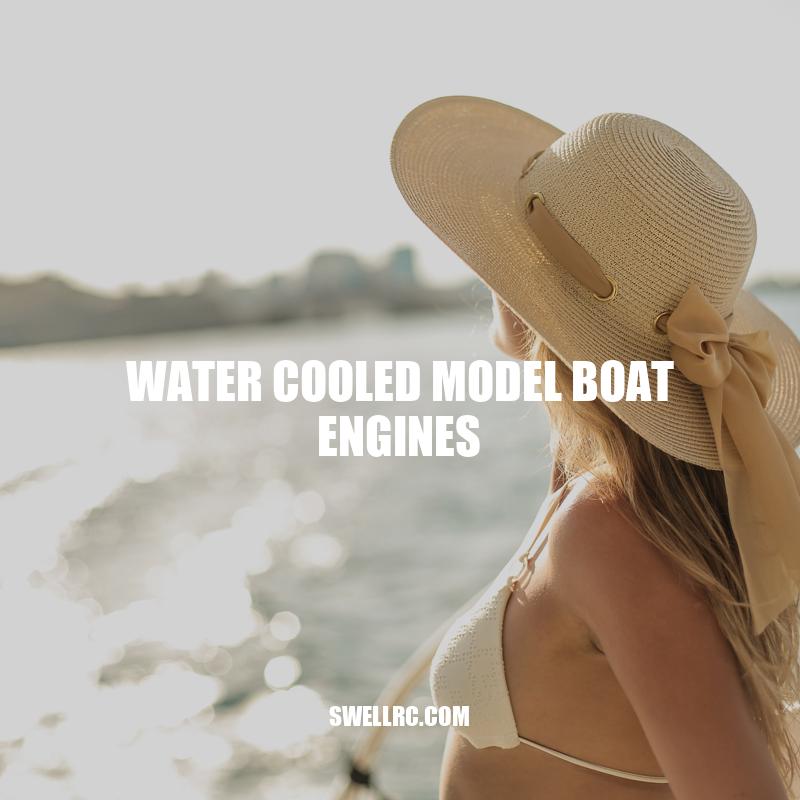Water-Cooled Model Boat Engines: Benefits and Maintenance Tips
Water-cooled model boat engines have revolutionized the model boating industry. Unlike their air-cooled counterparts, these engines come with a special cooling system that helps them run more efficiently and effectively. They do not overheat as air-cooled engines do, which is a huge benefit for those who use boats in hot weather conditions. Furthermore, their cooling system ensures they last longer compared to air-cooled engines. A water-cooled model boat engine is a complex machine made up of multiple components that work together to keep the engine running and maintains a constant temperature. In this article, we will discuss in detail how water-cooled model boat engines work, their benefits, maintenance requirements, common issues, and tips for choosing the right water-cooled model boat engine. Understanding these aspects is essential to enable you to get the most out of your boat, protecting its longevity, and maximizing your investment.
Benefits of water-cooled model boat engines
Water-cooled model boat engines offer several benefits over air-cooled engines. Some of the benefits include:
- Less possibility of overheating due to the engine’s cooling system
- Increases the overall durability of the engine
- Efficient and effective operation in cold and hot weather conditions
- Higher performance with less power loss
- Very reliable and easy to maintain
One excellent example of a water-cooled model boat engine available in the market is the Aquacraft Revolt 30. This engine powered by Dynamite .32 marine engine and comes equipped with a high-quality water-cooling system. It provides stable and efficient performance and requires less maintenance than several other engines. Along with being compatible with different types of models, the Aquacraft Revolt 30 is also affordable and easily accessible through different online stores.
If you are in search of an upgrade or a high-performance engine, the water-cooled model is the perfect choice for you. The benefits of the engine’s cooling system and its overall reliability offer optimal performance to your boat hobby without worrying about the engine’s maintenance.
What are the advantages of water-cooled engines over air-cooled engines?
Water-cooled engines have the following advantages over air-cooled engines:
- Better cooling efficiency
- Longer engine life
- Less noise and vibration
- Ability to control engine temperature
- Better fuel efficiency
Water-cooled engines use a circulation system to keep engine temperatures regulated, which in turn allows for better engine performance and durability. Air-cooled engines have more limited cooling options and as such tend to run hotter, which can wear down the engine. Water-cooled engines are also less noisy and vibrate less than air-cooled engines due to the circulating coolant. Additionally, monitoring and adjusting the temperature of a water-cooled engine is easier than with air-cooled engines. This results in better fuel efficiency, less wear and tear, and overall lower maintenance costs.
If you are in the market for a water-cooled engine, websites like JASPER Engines & Transmissions and Briggs & Stratton offer a range of options for various purposes.
Water-cooled engines are designed to maintain the temperature of the engine block consistently. The cooling system of the engine works as follows:
- Water is drawn from the lake, sea, or container through pickups located within the boat.
- Water then passes over the engine, carrying heat with it.
- The water absorbs heat from the engine block before exiting the boat through the exhaust.
- Water is then forced back through the hull again, to the pickups to continue the process.
One of the advantages of water-cooled model boat engines is that the system tends to make the engine run quieter and less vibrating than air-cooled engines. It is because the design of the water-cooled motors tends to dampen vibration within the engine compared to the air-cooled models. The water inside the engine provides the mechanism for reducing noise and vibration from the engine.
Below is a table of some of the best water-cooled model boat engines in the market:
| Brand | Model | Engine Displacement | Price |
|---|---|---|---|
| Aquacraft | Reef Racer 2 | 24cc | $299.99 |
| Atomik RC | Barbwire RC | 20cc | $219.99 |
| Pro Boat | Voracity Type E | 80cc | $1,399.99 |
These water-cooled model boat engines are some of the best available in the market and have unique features that make them a reliable and efficient choice for enthusiasts. The prices of these engines range from affordable to high-end, making it easier for everyone to get one compatible with their budget.
How does a water cooled engine work?
A water cooled engine works by circulating coolant/water mixture through passages in the engine block and cylinder head. The hot coolant absorbs heat from the engine and carries it to the radiator, where it’s cooled by air passing over the fins. Then, the cooled fluid returns to the engine. This cycle is maintained by a water pump, driven by the engine crankshaft.
In addition to the radiator, there are other types of cooling systems, such as air-cooled and oil-cooled. Each has its own advantages and disadvantages.
If you’re interested in learning more about engines and their workings, check out websites like howstuffworks.com or engineeringexplained.com. You can also find products like books and videos that delve deeper into the subject.
| Pros | Cons |
|---|---|
| – Efficient cooling allows tighter tolerances and reduces engine wear | – Requires a complex system of hoses, pumps, and a radiator |
| – Cooling performance isn’t affected by changes in outside temperature or altitude | – More weight due to the cooling system |
| – Quieter and more stable operating temperatures | – More expensive and difficult to repair if damaged |
- HowStuffWorks.com – An informative website that explains how things work
- EngineeringExplained.com – A YouTube channel hosted by an engineer that provides insightful explanations of engineering concepts and technology
- The Four-Stroke Dirt Bike Engine Building Handbook – A book by Eric Gorr that provides detailed information on engine building and performance tuning for off-road motorcycles
Maintenance requirements for water-cooled model boat engines
In addition to regular maintenance, the cooling system of water-cooled model boat engines requires specific attention to run efficiently and smoothly. Below are some essential maintenance requirements:
- Flush the engine with fresh water after each use to prevent mineral build-up inside the engine block.
- Check the engine’s cooling system for leaks or any irregularities before using it.
- Replace any damaged or worn-out parts of the cooling system from time to time.
- Ensure that the water pump stays functional and periodically replace the impellers to prevent blockages.
- Check for corrosion in the engine’s components and address it promptly.
It’s recommended that you follow the installation and maintenance concerns of the manufacturer‘s relevant water cooling model for your boat. Neglecting these regular maintenance operations could significantly harm your engine and reduce its lifespan.
Online websites offer a wide range of cooling system products and accessories for water-cooled model boat engines. These websites provide comprehensive engine maintenance tips, including product reviews, to match their customers with the appropriate products for their boats in terms of quality and budget.
Are boat engines water cooled?
Yes, most boat engines are water cooled. They use a system of pumps and hoses to circulate water from the body of water the boat is in, through the engine to keep it cool. This is important for the engine’s longevity and performance. For more information on boat engines and maintenance, you can check out websites such as Boats.com or BoatUS.com, or products such as the Mercury Marine SmartCraft system.
Common issues with water-cooled model boat engines
Despite their beneficial and sophisticated design, water-cooled model boat engines could face certain issues just like any marine engine. Below are some common issues that could occur, and how to address them:
- Overheating: Check the cooling system for blockages, holes, or damage. Replace any damaged parts immediately, and ensure that the water pump impellers are functioning correctly.
- Leaks: Inspect all hoses and connection points in the cooling system for leaks. Fix any leaks and replace any damaged or worn-out parts immediately.
- Noise: Abnormal engine noise could result from damaged water pump impellers, incorrect assembly or installation of components, or wear and tear of the engine.
- Lack of water flow: Check all parts of the cooling system for blockages or obstructions. Thoroughly clean the components and check their quality.
It’s essential to address any engine problems promptly to prevent further damages or costly repairs. You can also visit online websites or forums to inquire about the possible causes of engine problems and ways to fix them. Reputable websites and reliable customer reviews offer valuable insight into product quality, maintenance tips and resolving issues.
Why do boat engines not last long?
Boat engines may not last long due to a combination of factors. Here are some reasons why:
- Overheating: Running a boat engine at high speeds for extended periods can cause it to overheat, which can lead to damage or complete engine failure.
- Saltwater exposure: Saltwater can corrode engine parts, reducing their lifespan.
- Poor maintenance: Neglecting regular engine maintenance such as oil changes, filter replacements, and tune-ups can cause problems that shorten the engine’s life.
- Inferior quality: Some boat engines are made with low-quality materials, which can lead to problems and reduced lifespan.
It’s important to maintain your boat engine properly and invest in a high-quality model to ensure it lasts a long time. Some helpful resources for learning about boat engines and maintenance include BoatUS.com and WestMarine.com. They offer helpful tips and product recommendations to keep your boat running smoothly.
Tips for choosing the right water-cooled model boat engine
The following tips can help you to choose the best water-cooled model boat engine that suits your needs:
- Consider the size of your boat: The size and weight of your boat determine the size and power output of the engine required.
- Determine the boat’s activities: Consider the type of activities you’ll use the boat for. Do you need the engine for racing, fishing, or casual sailing? Choose an engine that matches your needs.
- Efficiency: Look for an engine that is fuel-efficient and has low emissions. This ensures that the engine runs smoothly while reducing environmental pollution.
- Reliability: Choose an engine from a brand that has a good reputation for reliability.
- Ease of maintenance: Opt for an engine that is easy to maintain and has readily available replacement parts. This will save you time, money and stress long term.
- Read reviews online: Check reviews of the engine or brand online from reputable websites such as BoatUS, Amazon or WestMarine. Take into consideration the experiences of other boat owners with similar boats and marine conditions. Their feedback can help you make an informed decision.
By following these tips, you can choose the best water-cooled model boat engine for your boat that is efficient, reliable and easy to maintain.
How do I know what water cooler to buy?
When buying a water cooler, consider the type of cooler that best suits your needs. Here are some factors to consider:
- Size and capacity: Think about how much water your family or office consumes in a day and choose a cooler with an appropriate capacity. A smaller family may need a counter top water cooler, while a larger family or office may require a floor-standing cooler.
- Temperature control: If you prefer your water cold or hot, make sure the cooler has both options or at least the temperature control that you need.
- Maintenance: Check if the cooler is easy to clean and whether filters need changing. With some coolers, you may also need to periodically check their warranty and potentially replace parts like compressors or thermostats.
- Price: Water coolers range in price from a few hundred dollars for basic models to over a thousand dollars for high-end water coolers with advanced features. Decide what features you want and how much you are willing to pay.
There are several websites and brands that offer water coolers. You may want to check out brand websites for product options and customer reviews. Retailers such as Amazon, Walmart, and Best Buy also have a selection of water coolers and can allow you to filter by specifications and price.
Conclusion
In conclusion, water-cooled model boat engines have revolutionized boating by enhancing the performance and extending the life of marine engines. These engines are more efficient, reliable and long-lasting compared to air-cooled marine engines. Maintaining the cooling system is critical to optimal engine performance. Taking care of your engine will save you money, stress and prolong the life of your engine. When choosing an engine, consider factors such as boat size, activities, efficiency, reliability, ease of maintenance and read online reviews. By following these tips, you’re sure to end up with an engine that fits your boat needs. Don’t forget to read user manuals and conduct regular maintenance checks, especially if your boat is used frequently. With proper care and maintenance, a water-cooled model boat engine is sure to provide a fantastic boating experience for years to come.



